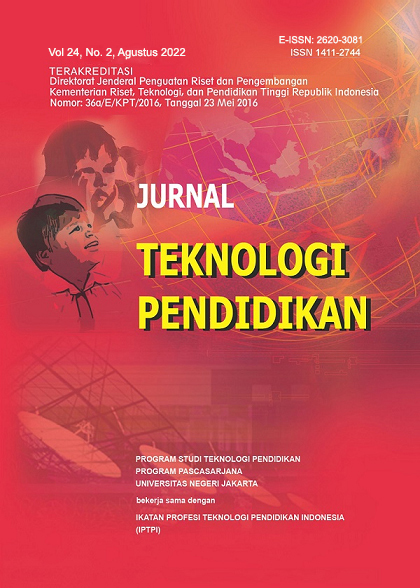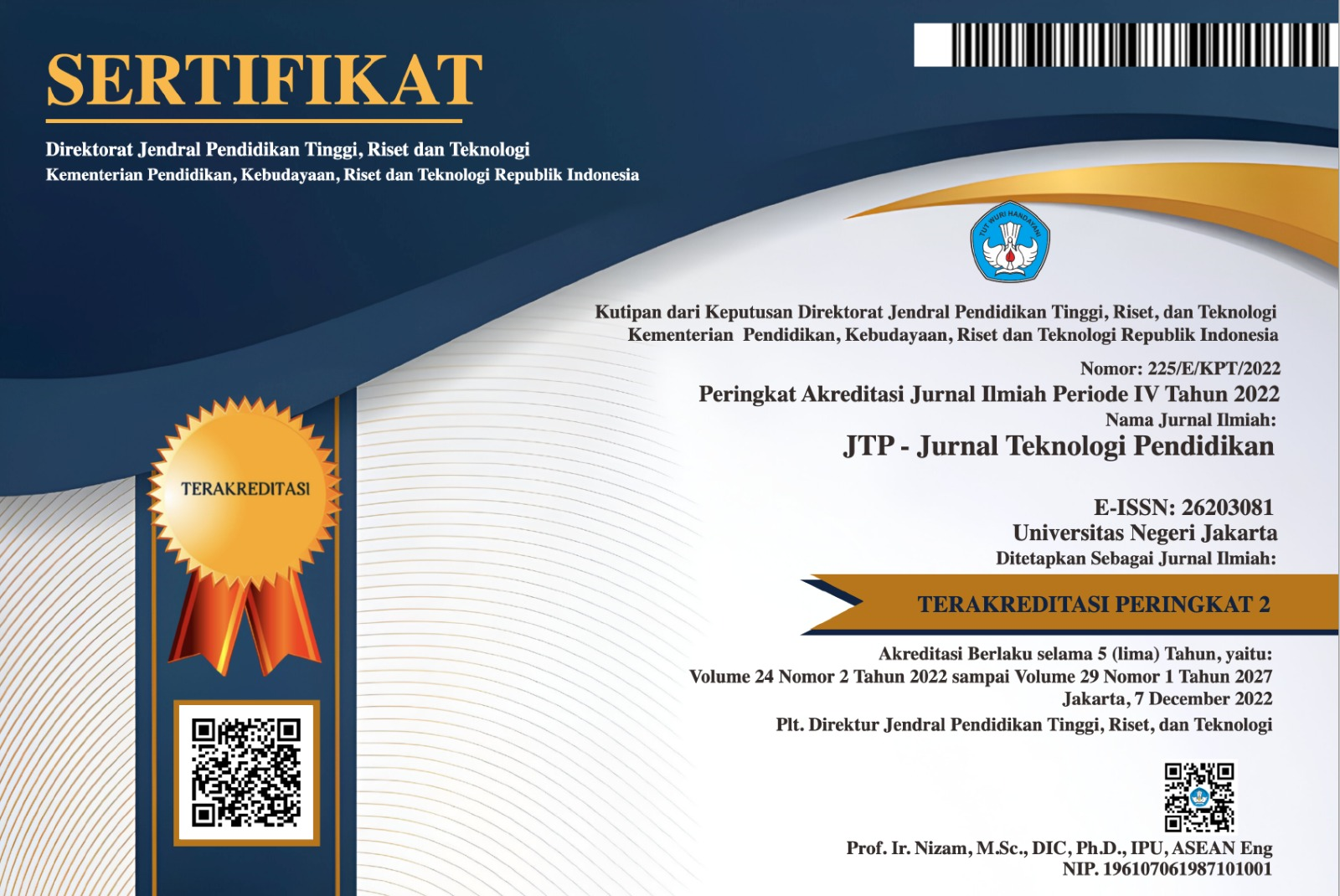Augmented Reality Visualization through Multirepresentations Approach in Chemistry Based on Qur’anic to Improve Cognitive Learning Outcomes
DOI:
https://doi.org/10.21009/jtp.v24i2.27097Keywords:
Augmented Reality, Chemistry, Learning Media, multirepresentation, qur'anicAbstract
media melalui visualisasi augmented reality berbasis pembelajaran al-Qur'an, dan mengkaji sejauh mana hasil belajar siswa yang menggunakan media tersebut. Untuk mewujudkan tujuan tersebut, pendekatan ADDIE (Analisis, Desain, Pengembangan, Implementasi, dan Evaluasi) digunakan untuk mengembangkan media. Berdasarkan temuan penelitian, media yang dikembangkan berupa buku berbasis smartphone dan berhasil divalidasi relevansinya oleh ahli media, ahli materi, guru, peer reviewer, dan siswa. Secara khusus, validasi mengungkapkan (1) 87,27% untuk relevansi produk; (2) 90,66% untuk materi IPA Al-Qur'an; (3) 82,85% untuk tanggapan peer reviewer dan guru; dan (4) 86,2% untuk respon siswa, khususnya pada materi multirepresentasi kimia (tingkat makroskopis, submikroskopis, dan simbolik). Implementasi yang dilakukan terhadap 100 siswa, menunjukkan bahwa media pembelajaran berpengaruh positif dan meningkatkan motivasi siswa dalam pembelajaran al-Qur'an dan kimia. Selain itu, berdasarkan hasil uji coba pretest dan posttest menggunakan analisis paired sample t-test terhadap 50 siswa diperoleh nilai signifikansi sebesar 0,000. Hal ini menunjukkan bahwa media pembelajaran ini terbukti mampu meningkatkan hasil belajar kognitif siswa.
References
Branch, R. M. (2009). Instructional Design: The ADDIE Approach. Springer Science & Business Media.
Cahyono, B. D., Muslim, S., & Djoko, D. (2019). The effect of Delphi-based on learning media at student learning outcomes in basic electricity and electronics subjects viewed from the level of student learning autonomy. Journal of Physics: Conference Series, 1360(1), 012028. https://doi.org/10.1088/1742-6596/1360/1/012028
Djamarah, S. B. (2011). Psikologi belajar. Rineka Cipta.
El-Mubarak, A. M. O. I., & Hassan, I. (2021). Challenges of Islamic Education in the Era of Globalization: A Proposed Holistic Solution. International Journal of Academic Research in Progressive Education and Development, 10(3), 337–349.
Fadillah, A., Dewi, N. P. L. C., Ridho, D., Majid, A. N., & Prastiwi, M. N. B. (2017). The effect of application of contextual teaching and learning (CTL) model-based on lesson study with mind mapping media to assess student learning outcomes on chemistry on colloid systems. International Journal of Science and Applied Science: Conference Series, 1(2), 101. https://doi.org/10.20961/ijsascs.v1i2.5128
Fitriyani, F., Sari, D. S., Mukmin, T., & Erlindawati, E. (2022). Teacher Professionalism in Islamic Religious Education During The Covid 19 Pandemic At Baitul A’la Islamic Primary School in Lubuklinggau. Edification Journal : Pendidikan Agama Islam, 4(2), 335–346. https://doi.org/10.37092/ej.v4i2.364
Herga, N. R., Čagran, B., & Dinevski, D. (2016). Virtual Laboratory in the Role of Dynamic Visualisation for Better Understanding of Chemistry in Primary School. Eurasia Journal of Mathematics, Science and Technology Education, 12(3), 593–608. https://doi.org/10.12973/eurasia.2016.1224a
Herliandry, L. D., Kuswanto, H., & Hidayatulloh, W. (2021). Improve Critical Thinking Ability Through Augmented Reality Assisted Worksheets: 6th International Seminar on Science Education (ISSE 2020), Yogyakarta, Indonesia. https://doi.org/10.2991/assehr.k.210326.067
Khaidir, E., & Suud, F. M. (2020). Islamic Education in Forming Students’ Characters at As-Shofa Islamic High School, Pekanbaru Riau. International Journal of Islamic Educational Psychology, 1(1), 50–63. https://doi.org/10.18196/ijiep.1105
Kompaniets, A., Chemerys, H., & Krasheninnik, I. (2020). Using 3D modelling in design training simulator with augmented reality. http://ds.knu.edu.ua/jspui/handle/123456789/2160
Lisana, L., & Suciadi, M. F. (2021). The Acceptance of Mobile Learning: A Case Study of 3D Simulation Android App for Learning Physics. International Journal of Interactive Mobile Technologies (IJIM), 15(17), 205. https://doi.org/10.3991/ijim.v15i17.23731
Lutfi, A., & Hidayah, R. (2021). Gamification for Science Learning Media Challenges of Teacher and Expectations of Students. International Journal of Interactive Mobile Technologies (IJIM), 15(01), 142. https://doi.org/10.3991/ijim.v15i01.15175
Manullang, S. O. (2020). Understanding of Modern Society Perception on Sociology of Islamic Law in Indonesia. International Journal of Humanities, Literature and Arts, 3(1), 85–92. https://doi.org/10.31295/ijhla.v3n1.230
McDermott, M. A., & Hand, B. (2013). The impact of embedding multiple modes of representation within writing tasks on high school students’ chemistry understanding. Instructional Science, 41(1), 217–246. https://doi.org/10.1007/s11251-012-9225-6
Morgan, G. A., Leech, N. L., Gloeckner, G. W., & Barrett, K. C. (2004). SPSS for Introductory Statistics: Use and Interpretation, Second Edition. Psychology Press.
Mubarok, M.S., Sanusi, A. and Mulyasana, D. (2018). Integrative learning pattern (science and religion) in high school.
Mustaqim, I. (2016). Pemanfaatan Augmented Reality Sebagai Media Pembelajaran. Jurnal Pendidikan Teknologi Dan Kejuruan, 13(2), 174–183. https://doi.org/10.23887/jptk-undiksha.v13i2.8525
Nechypurenko, P. P., Stoliarenko, V. G., Starova, T. V., Selivanova, T. V., Markova, O. M., Modlo, Y. O., & Shmeltser, E. O. (2020). Development and implementation of educational resources in chemistry with elements of augmented reality. http://elibrary.kdpu.edu.ua/xmlui/handle/123456789/3751
Nieminen, P., Savinainen, A., & Viiri, J. (2010). Force Concept Inventory-based multiple-choice test for investigating students’ representational consistency. Physical Review Special Topics - Physics Education Research, 6(2), 020109. https://doi.org/10.1103/PhysRevSTPER.6.020109
Ozdamli, F., & Hursen, C. (2017). An Emerging Technology: Augmented Reality to Promote Learning. International Journal of Emerging Technologies in Learning (IJET), 12(11), 121. https://doi.org/10.3991/ijet.v12i11.7354
Peterson, C. (2003). Bringing ADDIE to Life: Instructional Design at Its Best. Journal of Educational Multimedia and Hypermedia, 12(3), 227–241.
Pulungan, S. (2017). Pemanfaatan ICT Dalam Pembelajaran PAI. Query: Journal of Information Systems, 1(01), Article 01. http://jurnal.uinsu.ac.id/index.php/query/article/view/636
Puspitarini, Y. D., & Hanif, M. (2019). Using Learning Media to Increase Learning Motivation in Elementary School. Anatolian Journal of Education, 4(2), 53–60.
Riduwan. (2012). Measurement Scale of Research Variables. Alfabeta.
Sakat, A. A., Zin, M. Z. M., Muhamad, R., A., A., Ahmad, N. A., & Kasmo, M. A. (2012). Educational Technology Media Method In Teaching And Learning Progress. Advances in Natural and Applied Sciences, 6(3), 484+. Gale Academic OneFile.
Shih, J.-L., Chuang, C.-W., & Hwang, G.-J. (2010). An Inquiry-based Mobile Learning Approach to Enhancing Social Science Learning Effectiveness. Journal of Educational Technology & Society, 13(4), 50–62.
Suarsana, I. M. (2021). Developing Interactive Digital Mathematics Book with Multi Representation Approach for Deaf Students. International Journal of Emerging Technologies in Learning (IJET), 16(13), 128. https://doi.org/10.3991/ijet.v16i13.22459
Sudirman, S., Mellawaty, M., Yaniawati, P., & Indrawan, R. (2020). Integrating Local Wisdom Forms in Augmented Reality Application: Impact Attitudes, Motivations and Understanding of Geometry of Pre-service Mathematics Teachers’. International Journal of Interactive Mobile Technologies (IJIM), 14(11), 91. https://doi.org/10.3991/ijim.v14i11.12183
Sugiyono. (2019). Metode Penelitian Pendidikan (Kuantitatif, Kualitatif, Kombinasi, R&D dan Penelitian Pendidikan). Alfabeta.
Suhandi, A., & Wibowo, F. C. (2012). Pendekatan Multirepresentasi Dalam Pembelajaran Usaha-Energi Dan Dampak Terhadap Pemahaman Konsep Mahasiswa. Jurnal Pendidikan Fisika Indonesia, 8(1), Article 1. https://doi.org/10.15294/jpfi.v8i1.1988
Syahri, W., Yusnaidar, Y., Muhaimin, M., & Habibi, A. (2021). Effectiveness of Multimedia Based on Multiple Representation of Hess’ Law: Concept and Skills of Pre-Service Science Teachers. International Journal of Instruction, 14(3), 451–462.
Syarif, F. (2020). Reintegration Of Religious Knowledge And General Knowledge (Criticism Of The Discourse Of Science Dichotomy. JURNAL TRANSFORMATIF (ISLAMIC STUDIES), 4(1), 1–18. https://doi.org/10.23971/tf.v4i1.1850
Syawaludin, A., Gunarhadi, & Rintayati, P. (2019). Development of Augmented Reality-Based Interactive Multimedia to Improve Critical Thinking Skills in Science Learning. International Journal of Instruction, 12(4), 331–344.
Wan Hamzah, W. M. A. F., Haji Ali, N., Mohd Saman, M. Y., Yusoff, M. H., & Yacob, A. (2015). Influence of Gamification on Students’ Motivation in using E-Learning Applications Based on the Motivational Design Model. International Journal of Emerging Technologies in Learning (IJET), 10(2), 30. https://doi.org/10.3991/ijet.v10i2.4355
Wati, W., Ardian, A., & Diani, R. (2016). Pengembangan bahan ajar pembelajaran fisika berbasis pendidikan karakter dengan model pembelajaran kooperatif pada materi rotasi benda tegar.
Yusoff, A. B. M., & Al, E. (2021). Metacognitives And Morals: The Qur’an As A Guide. Turkish Journal of Computer and Mathematics Education (TURCOMAT), 12(4), 659–664. https://doi.org/10.17762/turcomat.v12i4.550
Zuhdi, M. N., & Syamsuddin, S. (2018). The Contemporary Qur’anic Exegesis: Tracking Trends in The Interpretation of The Qur’an in Indonesia 2000-2010. JAWI, 1(1), Article 1. https://doi.org/10.24042/jw.v1i1.2840
Downloads
Published
How to Cite
Issue
Section
License
Jurnal Teknologi Pendidikan is an Open Access Journal. The authors who publish the manuscript in Jurnal Teknologi Pendidikan agree to the following terms.
Attribution-ShareAlike 4.0 International (CC BY-SA 4.0)
-
Attribution — You must give appropriate credit, provide a link to the license, and indicate if changes were made. You may do so in any reasonable manner, but not in any way that suggests the licensor endorses you or your use.
-
ShareAlike — If you remix, transform, or build upon the material, you must distribute your contributions under the same license as the original.
- No additional restrictions — You may not apply legal terms or technological measures that legally restrict others from doing anything the license permits.
Notices:
- You do not have to comply with the license for elements of the material in the public domain or where your use is permitted by an applicable exception or limitation.
- No warranties are given. The license may not give you all of the permissions necessary for your intended use. For example, other rights such as publicity, privacy, or moral rights may limit how you use the material.








